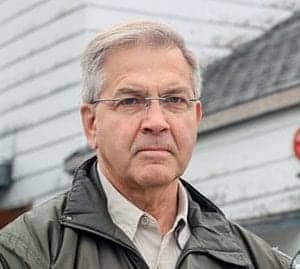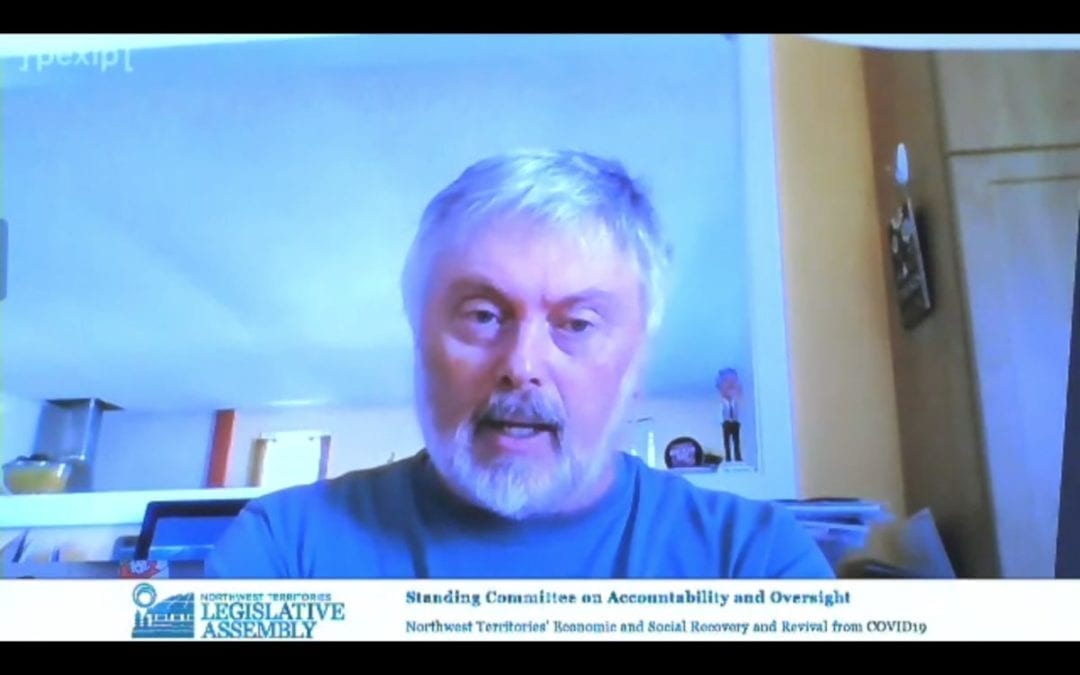The GNWT’s Emerge Stronger Plan for economic and social recovery from the Covid-19 pandemic makes little mention of the main driver of the NWT’s economy: mining.
“You need to have a recovery plan that addresses the foundation of the economy. We weren’t consulted on this (plan). They didn't talk to us about it,” said Tom Hoefer, executive director of the NWT and Nunavut Chamber Of Mines.

That plan was presented in a livestream last Wednesday to the Standing Committee on Accountability and Oversight -- members of Cabinet and MLAs also joined the meeting.
RELATED REPORTING: MLAs tell Cabinet to focus on small business while rebuilding NWT economy
But Hoefer said the presentation was “weak” and pointed to the sole “obtuse” reference to mining in the strategy, which came on a slide titled “What is expected to be different” after the pandemic. It referred to the mining and oil and gas sectors as externally focused based on the global market.
Another slide titled “Role of Government in Economic Recovery” advises the GNWT to “recognize and plan for shifts including the digital economy (and) declining oil and gas sector." Hoefer finds that puzzling because mining, at approximately 35 per cent of territorial gross domestic product (GDP), dwarfs oil and gas.
"If you’re going to triage something then you should triage mining,” he said. "Are you not in tune with the economy?"
When MLAs responded to the presentation on Wednesday, the only mention made of mining was by Frame Lake MLA Kevin O’Reilly, who said the GNWT should focus on supporting small businesses and not “spend too much time on trying to help the diamond mines recover. We don’t have deep enough pockets. We need to shift the focus to small business where we have some influence, particularly when it comes to government spending.”

In response, Hoefer said if the government is on the same page as O’Reilly then the recovery plan will be incomplete.
“There might be an association with Alternatives North. There's a group that's got this approach of not supporting the mining industry. That's not a way to diversify an economy. We should be looking at supporting all industries.”
Premier Caroline Cochrane, speaking to reporters in a teleconference on Tuesday, said the recovery plan presentation didn't make more mention of mines because it was a model, not a plan.
But she said the concerns of the mining industry won't be left out of the NWT's recovery strategy.
"The NWT & Nunavut Chamber of Mines are critical in the work as we go forward and they’ll be sitting on our business advisory council. They’ll have a huge amount to say on the economic measures that we bring forward."
Feds offer little help for mining industry
The lack of focus on mining in the GNWT’s recovery plan comes at a time when the Northern minerals industry is receiving little, if any, federal support during the pandemic.
The NWT and Nunavut Chambers of Mines, along with its Yukon counterpart, raised the issue in a letter on April 6 to federal Northern Affairs Minister Dan Vandal.
They pointed to the Canada Emergency Wage Subsidy (CEWS) program’s condition that companies must have lost 30 per cent of revenue from the same period last year as "problematic for many of our members" because of the realities of uneven revenue streams, non-revenue generating exploration activities and the seasonality of mining work.
More than a week later, MP Michael McLeod wrote a letter to Finance Minister Bill Morneau outlining the hardships faced by the mining industry, "the largest private sector employer and contributor to the gross domestic product in all three territories.”
McLeod reiterated points made by the chamber of mines about the CEWS program and urged that a more creative approach be found to address the needs of non-revenue generating companies like mining firms.
Hoefer is concerned that the GNWT’s recovery plan seems to have glossed over the fact the mining industry hasn’t received federal aid.
“We're getting no reports that our industry is getting any of that. It flies in the face of helping the economy get going. We're not sure we're eligible for these subsidies. Despite (the mineral industry) raising $5 billion in revenue over the last 10 years in the three territories, that's not considered revenue and most of that was done by small exploration companies,” he explained. “(The mines) are paying workers that they sent home to the Indigenous communities and they're dealing with more mitigations because of Covid. Is there some plan to help stop the bleeding?”
During her teleconference, Cochrane said support for mining has been on the agenda of most provincial and territorial premiers, who have been asking the federal government for more help.
"We’re looking at moving forward. We’ve released economic packages for residents from the GNWT. The next package we'll be releasing will be more based on the work that we're doing with this economic and social recovery plan."
Potential solutions
Criticisms aside, the mining chamber's executive director believes there are options that the territorial and federal governments could pursue to include the mining industry in a recovery strategy.
One is the GNWT’s $1 million Mining Incentive Program (MIP) that offers funding to help companies enhance their exploration activities.
“Maybe the government can double or triple (the amount). These are the things that have to be looked at. When things are really bad is it worth it to incent it to a higher degree?”
There is also the federal Mineral Exploration Tax Credit (METC), a 15 per cent non-refundable tax credit. Hoefer thinks it could be more effective in the NWT if the percentage was raised to take into account the higher costs of business operations in the territories.
“Why not make the METC four times higher in the North, so companies have a greater ability to raise money after this pandemic?” he suggested.
Other proposals, like the Taltson Hydroelectricity Expansion Project, the Slave Geological Province Corridor Project and the Mackenzie Valley Highway could help catalyze investment even during the pandemic.
“We have to think about the short-term, medium-term and long-term,” Hoefer said. “Do we have to act more boldly now than before? I would say yes we do. We've really dragged our economy down. They're going to have to throw more horsepower behind getting us out of this slump. With the 2008-2009 recession, everyone worked hard to get out of that. We need those sort of bold actions again. We're probably in worse condition now than we were in 2008-2009.”